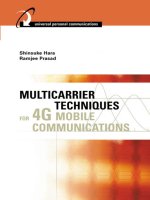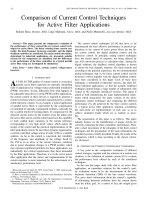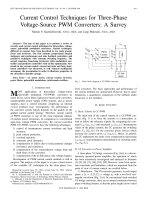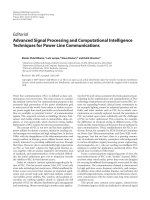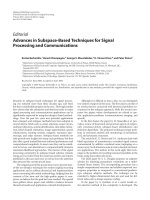Springer scrambling techniques for cdma communications byeong gi lee isbn 0792374266 jun 2001 ebooks corner
Bạn đang xem bản rút gọn của tài liệu. Xem và tải ngay bản đầy đủ của tài liệu tại đây (13.79 MB, 361 trang )
AM
FL
Y
TE
Team-Fly®
SCRAMBLING TECHNIQUES FOR
CDMA COMMUNICATIONS
THE KLUWER INTERNATIONAL SERIES
IN ENGINEERING AND COMPUTER SCIENCE
SCRAMBLING TECHNIQUES FOR
CDMA COMMUNICATIONS
by
Byeong Gi Lee
Seoul National University
Byoung-Hoon Kim
GCT Semiconductor, Inc.
KLUWER ACADEMIC PUBLISHERS
NEW YORK, BOSTON, DORDRECHT, LONDON, MOSCOW
eBook ISBN:
Print ISBN:
0-306-47321-6
0-792-37426-6
©2002 Kluwer Academic Publishers
New York, Boston, Dordrecht, London, Moscow
All rights reserved
No part of this eBook may be reproduced or transmitted in any form or by any means, electronic,
mechanical, recording, or otherwise, without written consent from the Publisher
Created in the United States of America
Visit Kluwer Online at:
and Kluwer's eBookstore at:
Contents
Preface
Acknowledgments
1. INTRODUCTION
ix
xi
1
Part I Scrambling Code Generation and Acquisition
2. SEQUENCES AND SHIFT REGISTER GENERATORS
1. Linear Sequences: M-, Gold-, and Kasami-Sequences
2. Shift Register Generator Theory
15
16
21
3. FUNDAMENTAL CODE ACQUISITION TECHNIQUES
1. Correlator vs. Matched Filter
2. Serial vs. Parallel Search
3. Z- vs. Expanding Window Search
4. Single vs. Multiple Dwell
5. Short vs. Long Code Acquisition
29
29
31
33
35
37
4. ADVANCED CODE ACQUISITION TECHNIQUES
1. Rapid Acquisition by Sequential Estimation (RASE)
2. Sequential Detection-based Acquisition
3. Auxiliary Sequence-based Acquisition
4. Acquisition based on Postdetection Integration
5. Acquisition based on Interference Reference Filler
6. Differentially-Coherent Acquisition
7. Acquisition in the Presence of Code-Doppler Shift
8. Acquisition by Distributed SRG State Sample Conveyance
41
41
48
53
60
62
67
73
75
Part II Spreading and Scrambling in IMT-2000 DS/CDMA Systems
5. INTER-CELL ASYNCHRONOUS IMT-2000 W-CDMA SYSTEM
(3GPP-FDD)
v
85
SCRAMBLING TECHNIQUES FOR CDMA COMMUNICATIONS
vi
1.
2.
3.
4.
5.
6.
7.
8.
9.
Transport Channels and Physical Channels
Timing Relations
Power Control
Downlink Transmit Diversity
Multiplexing and Channel Coding
Measurements
Uplink Spreading and Scrambling
Downlink Spreading and Scrambling
Cell Search
6. INTER-CELL SYNCHRONOUS IMT-2000 TD-CDMA SYSTEM
(3GPP-TDD)
1.
Transport Channels and Physical Channels
2.
Transmit Diversity and Beacon Functions
3.
Transmit Power Control
4.
Timing Advance
5.
Multiplexing, Channel Coding, and Measurements
6.
Data modulation
7.
Spreading and Scrambling
8.
Synchronization Codes
9.
Cell Search
86
96
99
100
104
113
117
129
136
149
150
161
162
163
164
164
165
167
170
7. INTER-CELL SYNCHRONOUS IS-95 AND CDMA2000 SYSTEMS
(3GPP-2)
173
173
1.
Timing Alignment through External Timing Reference
2.
Uplink Spreading and Scrambling
176
3.
Downlink Spreading and Scrambling
181
Part III
DSA-based Scrambling Code Acquisition
8. DISTRIBUTED SAMPLE ACQUISITION (DSA) TECHNIQUES
1.
Principles of the DSA
2.
Performance Analysis of the DSA
3.
Batch DSA (BDSA)
4.
Parallel DSA (PDSA)
5.
Differential DSA (D2SA)
189
189
203
219
231
238
9. CORRELATION-AIDED DSA (CDSA) TECHNIQUES
1.
Principles of the CDSA
2.
Application to Inter-Cell Synchronous Systems
3.
Application to Inter-Cell Asynchronous Systems
261
261
272
285
Appendices
A– Proofs and Lemmas for Theorems in Chapter 8
309
309
Contents
1.
Proof of “If ” Part of Theorem 8.5
2.
Proof of “Only If” Part of Theorem 8.5
3.
Lemma A.1
4.
Lemma A.2
5.
Lemma A.3
6.
Lemma A.4
7.
Lemma A.5
B– Derivation of Equations in Chapters 8 and 9
1.
Derivation of Eq.(8.80)
2.
Derivation of Eq.(8.89)
3.
Derivation of Eq.(9.4)
4.
Derivation of Eq.(9.8)
5.
Derivation of Mean Acquisition Time for
C– List of Acronyms
References
Index
vii
309
310
311
312
313
314
315
317
317
317
318
321
Parallel Search 323
325
331
343
This page intentionally left blank
Preface
With the advent of IMT-2000, CDMA has emerged at the focal point of
interest in wireless communications. Now it has become impossible to discuss
wireless communications without knowing the CDMA technologies. There are
a number of books readily published on the CDMA technologies, but they are
mostly dealing with the traditional spread-spectrum technologies and the IS-95
based CDMA systems. As a large number of novel and interesting technologies
have been newly developed throughout the IMT-2000 standardization process
in very recent years, new reference books are now demanding that address the
diverse spectrum of the new CDMA technologies.
Spreading, Scrambling and Synchronization, collectively, is a key component of the CDMA technologies necessary for the initialization of all types of
CDMA communications. It is a technology unique to the CDMA communications, and thus understanding of the spreading and scrambling techniques
is essential for a complete understanding of the CDMA systems. Research
of the spreading/scrambling techniques is closely related to that of the code
synchronization and identification techniques, and the structure of a CDMA
system takes substantially different form depending on the adopted spreading/scrambling methods.
The IMT-2000 standardization has brought about two different types of
CDMA technologies which require different forms of spreading/scrambling
techniques - - cdma2000 system and wideband CDMA (W-CDMA) system.
The fundamental distinction of the two systems is that the cdma2000 is an
inter-cell synchronous system, whereas the W-CDMA is an inter-cell asynchronous system. In the case of the inter-cell synchronous DS/CDMA systems
whose earlier example was the IS-95 system, every cell in the cellular system
employs a common scrambling sequence with each cell being distinguished by
the phase offset of the common sequence, which inevitably necessitates some
kind of external timing references for the coordination among the cells. In
the case of the inter-cell asynchronous DS/CDMA systems, however, each cell
ix
x
SCRAMBLING TECHNIQUES FOR CDMA COMMUNICATIONS
AM
FL
Y
employs different scrambling codes, thereby eliminating the dependency on the
external timing references. Cell search and synchronization in this environment
becomes a very challenging problem, as allocating different codes to different
cells imposes big burden in terms of cell search speed and the related circuit
complexity.
There have been reported a considerable amount of works on developing
efficient cell search (or scrambling code and timing acquisition) techniques in
very recent years, including three-stage search technique adopted as the WCDMA standard. However, this technique has much room for improvement,
and researches are still on-going to develop more efficient cell search methods.
The distributed sample-based acquisition (DSA) technique among the newly
emerging techniques may prove to be a highly potential candidate in the future
due to its rapid and robust acquisition capability.
TE
This book is intended to deal with the scrambling techniques for use in
the CDMA systems, including the synchronous and asynchronous EMT-2000
CDMA systems and those yet to come beyond. It provides some background
and fundamentals on sequences and shift register generators in the beginning,
and then focuses on various acquisition techniques in the primitive and advanced
levels. Much stress is put on spreading and scrambling of the synchronous
and asynchronous IMT-2000 systems and other recent code synchronization
techniques. Above all, this book has the unique feature that it introduces,
comprehensively and thoroughly, the novel acquisition technique DSA and its
family, invented by the authors themselves.
It is hoped that the contents of this book appear valuable to wireless communication engineers, especially to those involved in theoretical and design works
on spreading, scrambling and synchronization of the CDMA communication
systems.
Team-Fly®
Acknowledgments
This book may be called a sequel of the book Scrambling Techniques for
Digital Transmission authored by one of us (BGL) and Dr. Seok Chang Kim
(published by Springer-Verlag in 1994) in the sense that the theoretical foundation established in the digital transmission environment is applied to CDMA
communications in this book: The DSA technique, which is a main theme of
this book, is firmly rooted on the DSS theory addressed in the previous book.
We recollect the unequaled talents of the deceased coauthor (SCK) who established a solid theoretical foundation of the scrambling techniques for digital
transmission, with gratitude and admiration.
This publication is made possible thanks to the helps of several graduate
students at Telecommunications and Signal Processing (TSP) Laboratory of
Seoul National University and the comfortable research environments provided
by Seoul National University, Seoul, Korea, and George Washington University,
Washington, DC, USA.
We gratefully acknowledge the contributions of Myung-Kwang Byun, Daeyoung Park, Byeong-Kook Jeong, and Hanbyul Seo in summarizing various
references to help writing Chapters 3 and 4. In particular, we are indebted
to Daeyoung Park who helped word-processing the text, drawing the figures,
formatting the tables, and compositioning the whole contents.
We thank Professors Yong Hwan Lee and Kwang Bok Lee at Seoul National
University and Professor Dong In Kim at University of Seoul for kindly reviewing some chapters of the book. Also we are thankful to GCT Semiconductor,
Inc. for allowing a grace period to one of us (BHK) to complete drafting the
main body of the text.
We would like to thank our wives, Hyeon Soon Kang and Ji-Young Lee,
whose love and support at home encouraged and enabled us to concentrate on
authoring the book and the related researches at work.
B YEONG G I L EE A N D B YOUNG -H OON K IM
xi
This page intentionally left blank
Chapter 1
INTRODUCTION
Wireless communication systems can be classified to frequency division multiple access (FDMA), time division multiple access (TDMA), and code division
multiple access (CDMA) systems in terms of the employed medium access technology. In the wireless cellular communications arena, FDMA was mainly employed in analog wireless systems such as AMPS, NMT, and TAGS, whereas
TDMA and has become dominant in digital wireless systems such as GSM,
USDC (IS-54), and PDC. CDMA was first applied to commercial use in 1996
through the IS-95 system and has become the standard medium access technology of the IMT-2000 systems 1 (see Fig. l.l). 2 CDMA is expected to be
the major medium access technology in the future public land mobile systems
owing to its potential capacity enhancement and the robustness in the multipath
fading channel environment.
CDMA or SSMA Communications
CDMA is uniquely featured by its spectrum-spreading randomization process employing a pseudo-noise (PN) sequence, thus is often called the spread
spectrum multiple access (SSMA). As different CDMA users take different PN
sequences, each CDMA receiver can discriminate and detect its own signal,
by regarding the signals transmitted by other users as noise-like interferences.
Fig. 1.2 depicts the block diagram of the generic CDMA (SSMA) communi1
UWC-136 is a TDMA based IMT-2000 standard system, while other systems are mostly CDMA based.
AMPS is an abbreviation for Advanced Mobile Phone System; NMT for Nordic Mobile Telephone; TACS
for Total Access Communication System; GSM for Global System for Mobile Communications; USDC
for United States Digital Cellular; IS for Interim Standard; PDC for Personal Digital Cellular; IMT for
2
International Mobile Telecommunications [1, 2].
1
2
SCRAMBLING TECHNIQUES FOR CDMA COMMUNICATIONS
cation systems. In the figure, the transmitter and the receiver contain the same
pseudo-noise generator.
While the user capacity, defined as the maximum number of simultaneously
communicating users, is hard-fixed by the number of allocated frequencies
or time slots in the case of the FDMA or TDMA systems, the CDMA user
capacity is soft in that the maximum number of users can vary over a wide
range depending on the propagation channel characteristics, signal transmission
power level, data traffic activity, and others. This soft capacity stems from the
unique medium access feature of the CDMA system that the entire common
medium is shared by all the active users, without being split into multiple
slots with each slot exclusively occupied by different user, as is the case in
FDMA or TDMA systems. As each CDMA user randomizes its signal into a
random noise, the signal collision among CDMA users can be avoided even
though they share the same medium and the same spectrum band. Therefore,
each CDMA user can fully exploit the entire medium until the interference
level proportional to the number of randomized multi-user signals disables
the information conveyance over the medium. This medium sharing method
brings forth potential enhancement of user capacity over the medium split-anddedication method owing to the statistical multiplexing gain principle [3]. It is
especially beneficial when the data rate is time-varying, which is commonplace
in practical communication applications.
Introduction
3
The CDMA systems are further subdivided into the direct-sequence (DS)
CDMA, the frequency-hopping (FH) CDMA, and the multi-earner (MC) CDMA
in the respect of spectrum-spreading method [4,5]. In the DS/CDMA systems,
a user-specific PN sequence with a high chip rate is directly multiplied to a
low symbol rate data sequence to expand the data spectrum. In the FH/CDMA
systems, a user-specific frequency pattern spread over a wide spectrum range
adjusts the carrier frequency of the transmitted user signal in every hopping in-
terval, making the wide spectrum fully exploited during the communication. In
the MC/CDMA systems, a user signal is copied and transmitted over multiple
modulated sub-carriers arranged in order in the wide spectrum, where each user
employs a unique amplitude coefficient sequence to modulate the sub-carriers.
The spectrum-spreading feature of the CDMA makes the communication
system very robust in the typical multipath fading environment. As the signal
bandwidth increases, the probability of deep fading for the entire signal band be-
comes very low. Thus the receiving side can detect the CDMA signal correctly
by using the partial information transmitted over good frequency bands for most
of the communication time. This partial spectrum attenuation phenomenon
caused by time-varying multipath channel is called frequency-selective fading,
and each CDMA receiver mitigates it effectively by employing some unique
signal processing methods. For example, the DS/CDMA receiver can intelligently combine the individual multipath signals by employing a RAKE system,
thereby maximizing the signal-to-noise ratio at the detector front-end.
In addition to the aforementioned features, the DS/CDMA has several advantages over the other multiple access technologies, which include soft handoff capability, high information security, simple frequency planning, high frequency reuse efficiency [6], and high transmission power efficiency. All these
advantages are rooted on the spectrum-spreading and scrambling processes that
employ PN sequences.
4
SCRAMBLING TECHNIQUES FOR CDMA COMMUNICATIONS
Spreading and Scrambling in DS/CDMA Systems
Spectrum-spreading and data randomization can be performed concurrently
in the DS/CDMA transmitter through the processing that multiplies a highrate (or, wide-band) PN chip sequence to a low-rate (or, narrow-band) data
sequence. The ratio of the chip rate to the data rate is called the processing
gain or the spreading factor of the resulting wide-band DS/CDMA signal. This
corresponds to the spectrum bandwidth expansion ratio of the data signal during
the conversion to the DS/CDMA signal.
However, in typical cellular applications, a DS/CDMA signal is generated
through two steps - - spreading and scrambling (see Fig. 1.3.): First, an orthogonal spreading code, or, channelization code, is multiplied to the data sequence,
which expands the signal bandwidth and makes each user’s signal orthogonal
to those of the other users (or the other data channels). In the downlink of the
IS-95 system, for example, the 64-long orthogonal Walsh codes are employed
for the spectrum-spreading and orthogonal channelization, and in the IMT-2000
W-CDMA and cdma2000 systems, the orthogonal variable spreading factor
(OVSF) codes take the role both in the downlink and in the uplink [7, 8, 9].
Secondly, the channelized data signal is randomized through multiplication
of a PN code, typically, of the same rate, which is the chip scrambling process.
The employed PN code is called the scrambling code of the signal. As the
transmitted DS/CDMA signal usually arrives at the receiving side via multiple
propagation paths with different delays, the orthogonality among data channels
imposed by the channelization processing cannot often be maintained at the
receiver front-end. Furthermore, as the auto- and cross-correlation property
Introduction
5
of the orthogonal channelization codes is very poor, the interference resulting
from the multipath propagation can critically degrade the data detection performance unless another counter-action is taken. Therefore, the scrambling
processing that randomizes the user signal while keeping a good correlation
property is essential in wireless DS/CDMA communications. In the downlink,
a cell-specific scrambling sequence is assigned to each cell, which makes both
the neighboring cell interferences and the camping cell multipath inteferences
appear like random noises at the front-end of the mobile station receiver. On
the other hand, in the uplink, a user-specific scrambling sequence is assigned
to each individual user, as the timing alignment among different users is not
guaranteed. When a group of users can control their transmission timings such
that their signals arrive at the receiver of the base station at the same time,
they may employ a common scrambling sequence and user-specific orthogonal
codes even in the uplink to get the benefit of interference minimization.
The scrambling code generation methods differ between the inter-cell synchronous and the inter-cell asynchronous DS/CDMA systems. In the inter-cell
synchronous systems such as the IS-95 and the cdma2000 [9, 10], all base and
mobile stations can align their timers to that of the external timing reference.
Thus, for the sake of acquisition circuit simplicity and system coordination
facilitation, a common scrambling code is employed in all the base and mobile stations in the system, with each station employing a unique phase shift
of the common scrambling code in order to prevent signal collision. On the
other hand, in the inter-cell asynchronous systems such as IMT2000 W-CDMA
[8, 11], each base station has its own timing reference, which disables employing a common scrambling code over the entire cellular system. Each of base
and mobile stations employs a unique scrambling code such that its signal does
not collide with those of the others in the system for any phase shift. As a result,
the scrambling code acquisition complexity increases significantly, as will be
illustrated in the next section.
Scrambling Code Acquisition Techniques
As the first-step signal processing in the DS/CDMA receiver the locally
generated scrambling sequence is synchronized to the one superimposed on the
received waveform. In general, this synchronization process is accomplished in
two steps - - code acquisition, which is a coarse alignment process bringing the
two scrambling sequences within one chip interval, and code tracking, which
is a fine tuning and synchronization-maintaining process [4].
In scrambling code acquisition, fast acquisition is one of the most important
goals, for which a considerable amount of research has been exerted during the
past decades [4,12,13]. Fig. 1.4 demonstrates a diverse set of scrambling code
6
SCRAMBLING TECHNIQUES FOR CDMA COMMUNICATIONS
Introduction
7
acquisition techniques that have been introduced to date, from fundamental
techniques to advanced techniques. 3
The conventional serial search scheme [12] has the advantage of simple hardware, but the acquisition time is very long for a long-period scrambling sequence
because its mean acquisition time is directly proportional to the period of the
scrambling sequence employed[14]. Several fast acquisition schemes have been
developed at the cost of increased complexity. For example, multiple-dwell approaches were introduced [15, 16] which usually employ a fast decision-rate
matched filter (MF) for initial searching and a conventional active correlator
for verification. This multiple-dwell acquisition process enabled to reduce the
mean acquisition time by several factors [4]. For the case when the a priori
probability for the code phase uncertainty is not uniformly distributed, several
time reduction strategies that resort to search pattern variations were proposed,
whose examples are Z-search, expanding window search, offset Z-search, and
others [4, 17, 18, 19]. Also several sequential test approaches, combined with
two threshold comparators and variable dwell time, were introduced for the
initial code acquisition process, which could reduce the mean acquisition time
further [20, 21, 22, 23].
Unfortunately, those fast acquisition schemes cannot provide the desired
level of fast acquisition for very long period scrambling sequences, as they
sequentially searched for the valid phase among all candidate local sequence
phases, which outnumber the order of the code period. For such a long sequence case the parallel acquisition scheme [24] might render a solution but
the hardware complexity, that is, the number of active correlators or matched
filters, would increase to the order of code period. To get around this problem,
serial-parallel hybrid schemes were proposed for practical use [25, 26, 27,28],
in which a long code sequence of period N was divided into M subsequences,
each of which having length N/M, and the acquisition circuit was composed
of M parallel matched filters.
Another fascinating trial which can reduce the acquisition time tremendously
with a small hardware increase can be found in estimating the state of the
involved shift register generator (SRG) directly, instead of aligning the code
phase based on the correlation value. In principle, it is possible to accomplish
code acquisition in about L time units if the current sequence of the transmitter
SRG of length L is available, which would take
time units otherwise by
employing conventional serial search schemes. Some earlier schemes called
the sequential estimation [29, 30, 31] made L consecutive hard decisions on
the incoming code chips using a chip-matched filter and then loaded them to
3
Refer to Chapters 3 and 4 for detailed descriptions of the scrambling code acquisition techniques. Chapter
3 deals with the fundamental acquisition techniques, whereas Chapter 4 deals with the other advanced
techniques.
8
SCRAMBLING TECHNIQUES FOR CDMA COMMUNICATIONS
AM
FL
Y
the receiver SRG as the current SRG states. They were successful in speeding
up the acquisition process by additionally employing some proper verification
logics. However, the performance degradation, caused by poor estimation of
each chip, made it difficult to apply them to the CDMA environment where
the average chip-SNR is very low [4]. Even in high SNR environment, in
fact, they are not suitable for practical use because, to estimate the chip values,
they require to recover the carrier phase before the acquisition process, which,
however, is nearly impossible. 4 Note that code acquisition cannot be achieved
in a coherent manner. From this viewpoint, the closed-loop coherent acquisition
scheme based on an auxiliary sequence [33, 34] is not practically feasible either,
in spite of its theoretical novelty.
In addition to fast acquisition, robust acquisition is another important issue
to consider in designing an acquisition system. Code acquisition is often conducted in very poor channel environment, where SNR is extremely low due to
TE
the shadowing effect, the channel is rapidly fading due to terminal movement,
or a considerable frequency offset exists between the transmitter and receiver
oscillator circuitry. Thus a new acquisition system often becomes useless in
practical environment unless it is designed to overcome all these obstacles.
As an approach to improve the low-SNR acquisition performance, a
differentially-coherent acquisition detector was proposed, which could provide an SNR gain of about 5dB over the conventional noncoherent acquisition
detectors without using carrier phase information [35]. To prevent the ac-
quisition performance degradation in fast fading channels, chip-differentially
coherent detection scheme was proposed, in which the receiver correlation operation is done based on a differentially-detected scrambling sequence [36].
The scheme is reported to be especially useful for code acquisition in very fast
Rayleigh fading or large frequency offset channels. On the other hand, for the
inter-satellite or underwater acoustic communications, in which the ratio of the
terminal velocity to the wave propagation velocity may become considerably
high, thereby causing causes the code-Doppler phenomenon (or, time compression of the scrambling sequence itself), several correlator-bank approaches that
jointly detect the code timing and the Doppler-shift were introduced to cope
with the code-Doppler effect [37, 38, 39]. Aside from those discussed above,
there are several additional factors to consider to improve the acquisition sys-
tem performances - - threshold-setting strategy [40, 41, 42, 43], multiple access
interference (MAI) effect [44, 45, 46, 47], postdetection integration [28, 48],
multipath and the multiple pilots [48], and so forth.
4
A differentially-coherent sequence estimation approach is introduced in [32], where they apply multi-
ple parity-check trinomial equations to estimate reliable chip values. The approach avoids the coherent
acquisition problem but requires relatively high computation complexity for low-SNR range operations.
Furthermore, it cannot work well in practical time-varying wireless channels.
Team-Fly®
Introduction
9
Recently, with the introduction of the inter-cell asynchronous systems such
as the IMT-2000 W-CDMA, the traditional code acquisition issue has entered
a new phase. The single code scheme adopted in the inter-cell synchronous
systems enables each mobile station to acquire the cell scrambling codes in
relatively short time with simple hardware. On the other hand, the inter-cell
asynchronous system assigns different PN sequences to different cell sites,
eliminating the dependency on external timing references. Consequently, very
sophisticated and complex acquisition schemes are needed to acquire the scram-
bling codes within the allowed time limit, and the code identity and the time
shift have to be searched simultaneously [49, 50, 51].
For a fast acquisition of the scrambling codes in the inter-cell asynchronous
systems, the 3GPP three-step synchronization scheme based on the generalized
hierarchical Golay (GHG) code[52] and the comma-free code [53, 54] has been
adopted as the IMT-2000 W-CDMA cell search (or, initial code synchronization) standard [8, 55]. The three steps in this scheme refer to slot boundary
identification based on matched filtering, code group and frame boundary identification, and cell-specific primary scrambling code identification. For the
1st and the 2nd steps, each base station respectively broadcasts the primary
synchronization code (PSC) and the secondary synchronization code (SSC) of
length 256 each through the synchronization channel (SCH) at every beginning
of the slot. In the 3rd step, the cell-specific primary scrambling code is identified
by correlating all candidate scrambling codes belonging to the identified code
group with the incoming primary common pilot channel (CPICH) sequence. 5
In very recent years, a new acquisition technique that realizes direct SRG
acquisition through distributed SRG state sample transmission has been introduced under the name of distributed sample-based acquisition (DSA) and
a family of variations including the correlation-aided DSA (CDSA) followed
[56]–[68]. DSA technique basically features two unique mechanisms - - distributed sampling-correction for synchronization of the SRG and distributed
conveyance of the state samples via a short period sequence. More specifically,
the state of the main SRG in the transmitter is sampled and conveyed to the receiver in a distributed manner, while the state samples are detected and applied
to correct the state of the main SRG in a progressive manner. For conveyance
of the distributed state samples, a short-period sequence called the igniter sequence is employed. The DSA turned out to be very effective in speeding up the
acquisition process at low complexity and making performance reliable even
in very poor channel environment. 6
5
to Chapters 5 and 6 for details of the three-step synchronization scheme in the 3GPP W-CDMA and
TD-CDMA systems. Chapter 7 deals with the spreading and scrambling in the 3GPP2 cdma2000 systems.
6
Refer to Chapters 8 and 9 for detailed descriptions on the DSA and CDSA techniques.
10
SCRAMBLING TECHNIQUES FOR CDMA COMMUNICATIONS
Organization of the Book
This book is intended to discuss the scrambling techniques in the wireless
communication environment, specifically, in the CDMA communication environment. The contents of the book is arranged into three parts collectively
dealing with the scrambling, spreading and synchronization techniques in the
DS/CDMA communication systems (see Fig. 1.5).
Part I covers the topics on basic sequences, sequence generation and acquisition. The key features of the popular m-sequences, Gold-sequences, and
Kasami-sequences, as well as the embedded SRG theories, are introduced in
Chapter 2. Fundamental scrambling code acquisition techniques are briefly addressed in Chapter 3, and advanced code acquisition techniques are discussed
in Chapter 4. Included in this selection of acquisition techniques are the rapid
acquisition by sequential estimation, the sequential detection based rapid ac-
quisition, the auxiliary sequence based acquisition, postdetection integration
techniques, differentially-coherent acquisition, the Doppler-resistant acquisition, and the distributed sample conveying acquisition.
Part II introduces the third-generation DS/CDMA cellular systems, focusing
on the scrambling and spreading techniques adopted in the systems. Chapters 5
and 6 deal with the IMT-2000 W-CDMA and TD-CDMA systems, respectively,
Introduction
11
and Chapter 7 introduces the cdma2000 system as an evolutionary system of
the existing IS-95 system. 7
Part III is dedicated to the DSA technique and its family. Chapter 8 describes the theory, organization, and operation of the DSA, and then extends
the discussion to BDSA, PDSA, and
Chapter 9 presents the CDSA tech-
nique that enhances acquisition robustness in low-SNR fading channels and
large frequency-offset environments. Lastly, it discusses the potential applications of the CDSA to the practical inter-cell synchronous (i.e., cdma2000) and
asynchronous (i.e., W-CDMA) IMT-2000 systems.
7
These three CDMA systems correspond, respectively, to the 3GPP-FDD, 3GPP-TDD, and 3GPP-2 systems
in Fig. 1.5, where 3GPP is an abbreviation for 3rd Generation Partnership Project, FDD for Frequency
Division Duplex, and TDD for Time Division Duplex.
This page intentionally left blank
